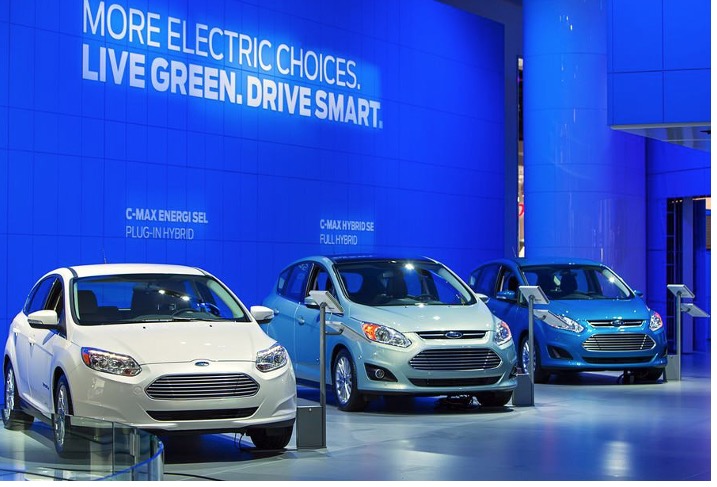CommentsPLANNING WATCH - Automobile companies in Asia, Europe, and the United States are investing over $500 billion in electric cars, led by two German car companies, Daimler and VW.
One reason for this massive investment is the need for automobile companies to comply with governmental requirements to decarbonize and increase fleet mileage levels. For example, in California, all new cars and passenger trucks must be zero-emission by 2035, only 12 years from now.
No surprise that investment newsletters now promote stocks in electric car companies. Their value is soaring in response to decarbonization requirements met by customers.
Because most electric models are sold to the top 17 percent of consumers who buy luxury cars, their marketing campaigns emphasize ease of operation, speed, trendiness, and climate benefits. But these climate benefits are exaggerated since the primary purpose of automobile companies is the generation of profits, not the reduction of their products’ Green House Gas emissions. Profitability, not climate benefits, keeps stockholders happy, Wall Street investors pleased, and CEO salaries high.
Tesla and Audi have already concluded that pricey electric cars are more profitable than cars with internal combustion engines, and their competitors will soon reach the same conclusion. This is why, according to the Wall Street Journal’s Holman Jenkins, automobile companies are robbing Peter to pay Paul. “Conventional vehicles will be starved for investment from here on out, even as auto makers throw money at big-battery EV’s for luxury buyers … The impact on climate for these cars will be zero.” Jenkins further argues that, “If a real incentive to reduce CO2 were in place, namely a carbon tax, buyers would gravitate to the smallest-battery vehicles and hybrids, suitable for running about town, but not highway trips. These cars stand a better chance of offsetting their lifecycle emissions.”
Guardian, “Tesla hits milestone in reporting a profit for its fourth straight quarter.”
Of course, the car companies’ advertising campaigns don’t mention the profitability of expensive electric vehicles. Instead, they emphasize that these models are trendy, powerful, fun to operate. and essential to fighting climate change.
But this last claim is not accurate for several reasons:
- Electric car batteries require an electric grid to charge, and in the U.S. most electricity is generated from coal and natural gas, not solar, hydroelectric, and wind.
- Electric cars are still cars. The iron, aluminum, copper, glass, and plastic in them must be extracted and refined to build the electric cars.
- Electric cars require roads, and in cities like L.A., the road system comprises about 40 percent of the city’s land mass. These roads require energy-intensive cement or asphalt to construct and maintain. This is why the Los Angeles Department of Transportation (LADOT) has 1,300 employees and StreetsLA (formerly the Bureau of Street Services) has 1,100 employees.
- To accommodate cars, streets must be wide enough for parking, and all buildings require garages, driveways, and parking lots or parking structures to function. While the building and zoning codes could reduce parking requirements, this does not eliminate the need for residents, employees, shoppers, and visitors to drive gasoline or electric cars.
These factors must be considered when calculating the total carbon footprint of electric cars, which is why most electric cars are comparable to gasoline engine vehicles for their first two years of operation. In addition, several other factors remain unchanged when a car’s energy source switches from gasoline to electricity.
First, electric cars, like gasoline cars, are mostly single occupancy vehicles. For several hours each day, the drivers are mostly alone, entertained by sound systems and cell phones. This social isolation is the same regardless of the car’s power source.
Second, most of the energy consumed by electric cars, like gasoline cars, is used to move the car, not drivers and occasional passengers. In comparison, alternative transportation modes, even those with hydrocarbon engines, have lower carbon footprints. Nevertheless, “green” auto companies don’t reinvest their profits in mass transit, carpools and vanpools, bicycles and scooters, and telecommuting (e.g., Zoom). If these giant corporations were committed to reducing Green House Emissions, this is what they would do instead of developing, building, and selling new, high performance, and highly profitable electric cars.
As I have previously written, real estate developers use a similar ploy to persuade journalists, elected officials, and academics to support the construction of highly profitable expensive condos and apartments. They claim these ventures solve the housing crisis and therefore reduce homelessness. Meanwhile, they totally avoid stating the obvious: these real estate projects line the pockets of investors and developers, while homelessness goes up when high-priced buildings go up. They ignore that part of the story, just like the energy-intensive metal, glass, and plastics required to manufacture electric cars, the electricity to operate them, and the roads, parking lots, and parking structures to integrate them into an auto-centric city like Los Angeles
Another parallel is military spending, which has now reached $800 billion per year for the Pentagon and $1.4 billion when other Federal government departments are included. The purpose of this enormous military spending is not to enrich military contractors, like Lockheed, but to “promote democracy, stop terrorism, and oppose authoritarian regimes.”
Is the end of the story? Cities, like LA, can still add, implement, and closely monitor Climate Change Elements in their General Plans that emphasize mass transit, tree planting, bicycles and scooter infrastructure, and upgraded sidewalks. They can also adopt ordinances that promote small electric cars with low carbon footprints instead of electric cars with enormous batteries, extended ranges, and high profits.
(Dick Platkin is a former Los Angeles city planner who reports on local planning issues for CityWatchLA. He serves on the boards of United Neighborhoods for Los Angeles (UN4LA) and the Greater Fairfax Residents Association. Previous Planning Watch columns are available at the CityWatchLA archives. Please send comments and corrections to [email protected].)
















